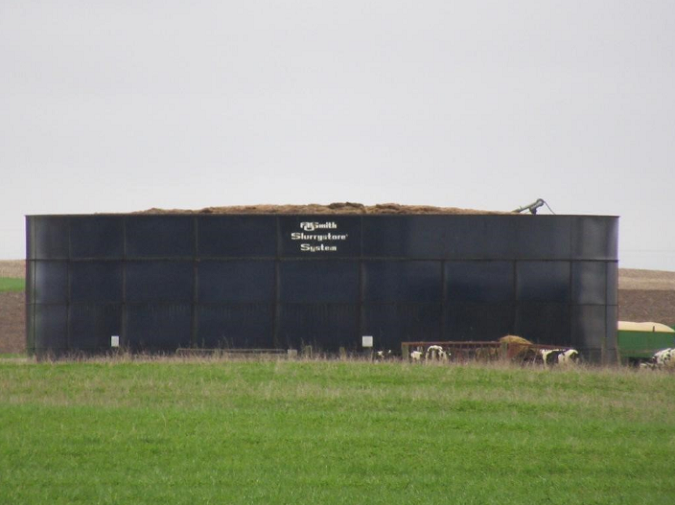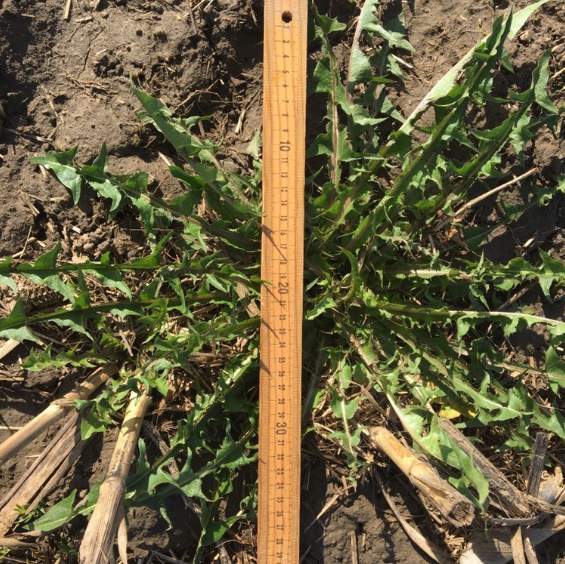The weather story continues this week with very little change across the province in terms of field activity, including fertilizer and pesticide application to wheat, manure application, field preparation and planting. A small number of acres were planted on the lighter soils across the province, where conditions permitted, but to date less than 10% of corn is in the ground. Rainfall amounts continue to vary across the province, however on-going lack of heat and sunshine are the biggest culprits in delaying progress.
Manure Application
Late harvest, wet soil conditions during fall of 2018, followed by current persistent wet weather have left many manure storages close to over-flowing (Figure 1.). Some emergency application has contributed to increased ruts and compaction. Consider planting at least some of the corn when soils are finally fit for planting, and then apply the liquid manure after planting. With draghose systems manure can be applied without hose damage to corn until sometime before the corn gets to 4th leaf (collar) stage. Not only will it improve nutrient use efficiency, but manure can be applied when soil conditions are more suitable. This helps prevent compaction, improve yield and can spread out some of the manure application workload in a delayed spring season. Other in-crop opportunities include application after forage harvest and application to soybean and edible bean fields. For application to bean crops, application rates should apply between 40-60 lbs of N as ammonium (NH4-N) to prevent lodging. A sample should be taken for analysis to determine the N-P-K and Sulfur applied. Manure application after wheat harvest, ideally with cover crops, is the ideal timing to avoid compaction and help with work load management.

Figure 1. A manure storage full to the top can be emptied in stages during the growing season to prevent additional corn planting delays.
Weed Control
Winter annual and perennial weeds are getting bigger and some species, like dandelion, will require higher rates of glyphosate (e.g. 1.34 L/acre of glyphosate 540 g/L) to achieve adequate control. Glyphosate resistant weeds like Canada fleabane are getting larger as well, spray coverage will be important to maximize control so increasing water volumes will help with improving coverage.

Figure 2: a dandelion in corn stubble slated for soybeans. Once dandelion gets beyond 15 cm in diameter a higher rate of glyphosate is needed for control.
Wheat
Eventual sun and warm temperatures will result in a flurry of activity. The to-do lists are long; therefore, prioritize activities and combine tasks when possible. A few guidelines to maximize wheat yield potential, especially on questionable fields:
Do not apply nitrogen, sulphur, herbicide and fungicide in one application.
Priority should be made on nitrogen and sulphur applications, followed by a herbicide application 3 days later if necessary.
If there is no disease pressure, then a fungicide tank-mixed with herbicides is not warranted.
Lack of growth in wheat fields continues to be a concern with a high number of acres still without full N application, and some still awaiting the “keep or release” decision. The good news for the reduced wheat crop is there is very little disease to date with the exception of powdery mildew. Producers should continue to scout for Septoria and virus diseases, and with sunshine and heat, physiological fleck will show up on some susceptible varieties. Stripe rust has been reported in one field in western Kentucky (Princeton – May 15) and has not been of concern in the US to date, even though potential for infection for stripe rust is higher in cool, humid conditions.
Corn and Soybeans
Early season soil pathogens thrive under current cool, wet conditions. For producers planting into less than ideal soil conditions, the result could be more early season seed rots, seedling blights and/or root rots showing up in corn and soybean fields, especially on heavier soil textures. Some of the most common culprits in corn and soybeans are Pythium, Fusarium, Rhizoctonia as well as Phytophthora but just on soybeans. When it comes to early season diseases, there is very little genetic resistance available in most corn hybrids or soybean varieties. Fungicide seed treatments are necessary to economically and effectively manage early season diseases since genetic resistance is often not enough under wet conditions on the clays. To avoid replants, especially in fields with chronic standing water, some seed companies and retailers are adding additional metalaxyl or similar fungicide active ingredient to the seed which will provide additional phytophthora and phythium root rot protection.
Other soybean diseases such as Fusarium root rot and Sudden Death Syndrome will benefit from these cool, wet conditions especially if conditions become drier in June followed by rain events. Again, fungicide seed treatments will provide some protection.
Canola
Ideally, spring canola is planted before mid-May, but planting opportunities have been limited to date. The crop insurance deadline for planting is June 10th for Area E (northern Ontario), June 5th for Area D (Bruce, Grey, Dufferin, north Simcoe, etc) and May 31 for areas A, B and C. Late planting increases the chances of having swede midge pressure before the crop bolts, and of having hot conditions during flowering.
Winter canola is now in bloom in most fields where it survived this tough winter and spring. Conditions are good for white mould development. Fungicides should be applied at 20 to 50% bloom. It takes approximately 10 days for plants to progress from first flower to 50% bloom. If stands are thin or uneven, it may take longer to reach 50% bloom.
Forages
Winterkill in alfalfa is widespread throughout the province. Producers need to scout their hay fields to determine the extend of the damage. With the planting season barely underway, there are lots of options to address winterkill.
Alfalfa is auto-toxic, which means mature plants produce chemicals that prevent new alfalfa plants from establishing. Stands planted in 2018 will not have this auto-toxic effect, but older stands cannot be patched or followed by alfalfa. Fields with less than 50% loss could be patched. Red clover is a good option to maintain legumes in the stand, while grasses provide more yield. Grass options for patching include Italian ryegrass or more typical perennial forage grasses. Fields that are patched this year should be terminated and rotated in 2020. Alternative forage crops to replace a winterkilled alfalfa field include red clover, Italian ryegrass, spring cereals or cereal/pea mixtures, sorghum-sudan grass, or millet. Plant into fit soil conditions, ensure good seed-to-soil contact, and plan to meet the crop’s fertility requirement. Don’t forget to factor in the nitrogen credit from winterkilled alfalfa! Be aware that these crops must be managed differently than alfalfa to get good quality and yield.
Source : Field Crop News